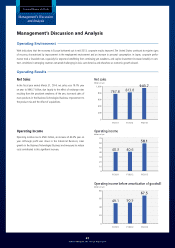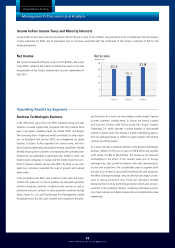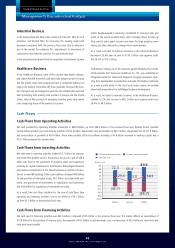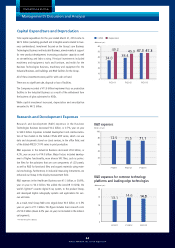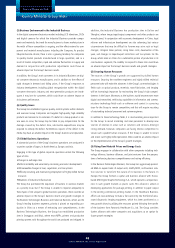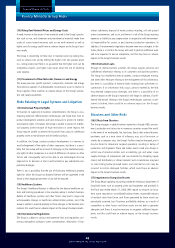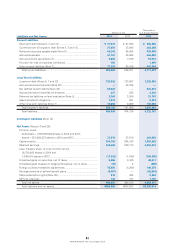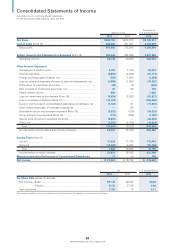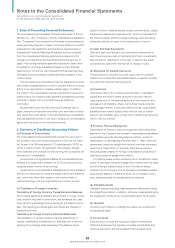Konica Minolta 2014 Annual Report Download - page 50
Download and view the complete annual report
Please find page 50 of the 2014 Konica Minolta annual report below. You can navigate through the pages in the report by either clicking on the pages listed below, or by using the keyword search tool below to find specific information within the annual report.
49
KONICA MINOLTA, INC. Annual Report 2014
Financial Review and Data
Konica Minolta Group Risks
(10) Rising Raw Material Prices and Energy Costs
A rapid increase in the prices of raw materials used in the Group’s produc-
tion such as iron, and aluminum and petrochemical materials made from
crude oil, scarce natural resources such as rare earth minerals as well as
higher costs for energy could have an adverse impact on the Group’s busi-
ness results.
The Group is responding to these rises in materials prices by taking mea-
sures to reduce costs and by shifting the higher costs into product prices
(i.e., raising prices), but there is no guarantee that the higher costs can be
completely covered, and higher sales prices entail the risk of declining
sales volumes.
(11) Procurement of Raw Materials, Resources and Energy
The Group procures specific products, components, materials and energy
from external suppliers. If unforeseeable circumstances occur in relation to
those suppliers, there could be an adverse impact on the Group’s produc-
tion and supply capabilities.
Risks Relating to Legal Systems and Litigation
(12) Intellectual Property Rights
To maintain its superiority in business competitiveness, the Group is accu-
mulating extensive differentiation technologies and know-how from its
product development activities and takes measures to protect its intellec-
tual property rights. If, however, the Group is unable to protect its intellec-
tual property assets because of legal restrictions in some regions, the
Group may be unable to prevent third parties from using its intellectual
property assets to manufacture and sell similar products.
In addition, the Group conducts product development in a manner to
avoid infringement of the rights of other companies, but there is a possi-
bility that the Group will be accused of infringing on the intellectual prop-
erty rights of other companies as a result of differences of opinion or other
factors and consequently will not be able to use technologies that are
important to its business or that it will be liable to pay substantial com-
pensatory damages.
There is also a possibility that the use of third-party intellectual property
rights for which the Group has obtained licenses will be suspended in the
future or that inappropriate terms of use will be imposed.
(13) Healthcare Systems
The Group’s Healthcare Business is affected by the diverse healthcare sys-
tems and licensing procedures in the countries where it conducts business.
Reform of healthcare systems and other factors may lead to large-scale
unforeseeable changes in healthcare administrative policies, and if the
Group is unable to respond promptly to those changes in the business envi-
ronment, this could have an adverse impact on the Group’s business results.
(14) Environmental Regulations
The Group is subject to various environmental laws and regulations con-
cerning atmospheric pollution, water contamination, elimination of haz-
ardous substances, disposal of waste, product recycling, soil and ground
water contamination, and so on, and there is a risk of the Group incurring
expenses or liability to pay compensation in conjunction with environmen-
tal responsibility for current or past business production operations. In
addition, if environmental regulations become even more stringent in the
future, there is a risk that the Group will need to perform additional work
and incur expenses to ensure compliance, and this may have an adverse
impact on the Group’s business results.
(15) Information Leaks
Through its diverse business activities, the Group acquires personal and
confidential information relating to its customers and business partners.
The Group has established internal systems, conducts employee training,
and takes other measures relating to the management of this information,
but there is a possibility of external leaks resulting from unforeseen cir-
cumstances. If an information leak occurs, persons harmed by the leak
may demand compensatory damages, and there is a possibility of an
adverse impact on the Group’s reputation and image. In addition, if confi-
dential information relating to the Group’s technologies, contracts, or per-
sonnel is leaked, there could be an adverse impact on the Group’s
business results.
Disasters and Other Risks
(16) Effects from Disasters
The Group engages in global business operations through R&D, procure-
ment, production and sales sites in numerous countries around the world.
In the event of an earthquake, fire, hurricane, flood, other natural disaster,
pandemic such as a new strain of influenza, war, act of terrorism, or
attacks by a computer virus, the Group’s facilities may be damaged, and it
may be forced to temporarily suspend operations, resulting in delays of
production and shipments. These and similar events could also disrupt or
restrict use of essential utilities such as electricity, gas and water; cause
supply shortages of components and raw materials by disrupting supply
chains; halt distribution; or disrupt markets. Such circumstances may lead
to sales falling below planned levels, and substantial costs may be
incurred to restore damaged facilities, which could have an adverse
impact on the Group’s business results.
(17) Impairment of Long-Lived Assets
The Group began applying accounting standards relating to impairment of
long-lived assets such as property, plant and equipment and goodwill in
the fiscal year ended March 31, 2006. With regard to amounts for long-
term assets reported on consolidated balance sheets, recoverable amount
of residual value from future cash flows generated by those assets are
periodically assessed, but if business profitability declines as a result of
competition or other factors and those assets are not able to generate
adequate cash flows, it may be necessary to recognize additional impair-
ment, and this could have an adverse impact on the Group’s business
results.




